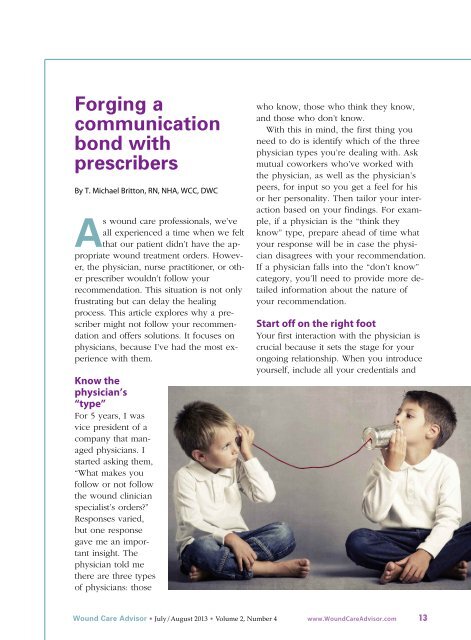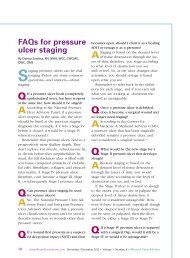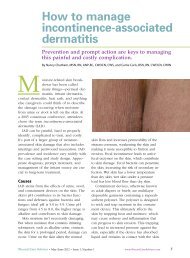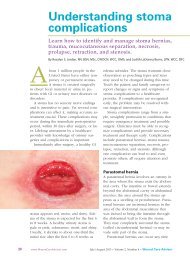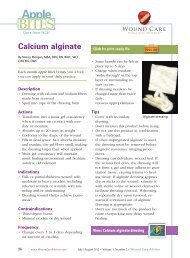SBAR communication tool - Wound Care Advisor
SBAR communication tool - Wound Care Advisor
SBAR communication tool - Wound Care Advisor
Create successful ePaper yourself
Turn your PDF publications into a flip-book with our unique Google optimized e-Paper software.
Forging a<br />
<strong>communication</strong><br />
bond with<br />
prescribers<br />
By T. Michael Britton, RN, NHA, WCC, DWC<br />
As wound care professionals, we’ve<br />
all experienced a time when we felt<br />
that our patient didn’t have the appropriate<br />
wound treatment orders. However,<br />
the physician, nurse practitioner, or other<br />
prescriber wouldn’t follow your<br />
recommendation. This situation is not only<br />
frustrating but can delay the healing<br />
process. This article explores why a prescriber<br />
might not follow your recommendation<br />
and offers solutions. It focuses on<br />
physicians, because I’ve had the most experience<br />
with them.<br />
Know the<br />
physician’s<br />
“type”<br />
For 5 years, I was<br />
vice president of a<br />
company that managed<br />
physicians. I<br />
started asking them,<br />
“What makes you<br />
follow or not follow<br />
the wound clinician<br />
specialist’s orders?”<br />
Responses varied,<br />
but one response<br />
gave me an important<br />
insight. The<br />
physician told me<br />
there are three types<br />
of physicians: those<br />
who know, those who think they know,<br />
and those who don’t know.<br />
With this in mind, the first thing you<br />
need to do is identify which of the three<br />
physician types you’re dealing with. Ask<br />
mutual coworkers who’ve worked with<br />
the physician, as well as the physician’s<br />
peers, for input so you get a feel for his<br />
or her personality. Then tailor your interaction<br />
based on your findings. For example,<br />
if a physician is the “think they<br />
know” type, prepare ahead of time what<br />
your response will be in case the physician<br />
disagrees with your recommendation.<br />
If a physician falls into the “don’t know”<br />
category, you’ll need to provide more detailed<br />
information about the nature of<br />
your recommendation.<br />
Start off on the right foot<br />
Your first interaction with the physician is<br />
crucial because it sets the stage for your<br />
ongoing relationship. When you introduce<br />
yourself, include all your credentials and<br />
<strong>Wound</strong> <strong>Care</strong> <strong>Advisor</strong> • July/August 2013 • Volume 2, Number 4 www.<strong>Wound</strong><strong>Care</strong><strong>Advisor</strong>.com 13
don’t be embarrassed to talk about your<br />
training and experience. If possible, you<br />
already should have assessed the patient<br />
and reviewed the chart. It may be helpful<br />
to have someone familiar to the physician<br />
and who knows your expertise provide<br />
the introduction.<br />
Make your case<br />
Physicians say that clinicians who make a<br />
recommendation commonly aren’t prepared<br />
to provide the information the<br />
physician needs to make an informed decision.<br />
Having your information organized<br />
and readily available increases the chance<br />
that the physician will accept your recommendation.<br />
Many <strong>tool</strong>s can help you get<br />
organized. One of the most user-friendly is<br />
<strong>SBAR</strong>—Situation, Background, Assessment,<br />
Recommendation. (See <strong>SBAR</strong> <strong>communication</strong><br />
<strong>tool</strong>.)<br />
Before you call or see the physician, be<br />
sure you can answer “yes” to the following<br />
questions:<br />
• Have I seen and assessed the patient<br />
myself (instead of relying on someone<br />
else’s report)?<br />
• Am I calling the right physician to<br />
address this situation? For example, can<br />
the patient’s primary care physician<br />
address the problem or do I need to call<br />
one of the consulting specialists?<br />
• Do I know the admitting diagnosis and<br />
admission date?<br />
• Have I read the most recent progress<br />
and nurses’ notes?<br />
• Do I have the patient’s chart available so<br />
I can easily access information, such as<br />
age, current medication, wound treat -<br />
ments, allergies, laboratory results, and<br />
most recent vital signs?<br />
• Do I know the patient’s resuscitation<br />
status?<br />
Know what to do in the case of<br />
inappropriate treatment<br />
If you believe the physician’s prior treatment<br />
orders were inappropriate, calmly<br />
express your concerns, and give rationales<br />
for your opinion. Be ready to cite a reputable<br />
source, such as protocols or research<br />
studies, to validate your position.<br />
Use correct medical terminology but don’t<br />
overcomplicate your language. Share your<br />
ideas for alternatives and try to get permission<br />
for a trial period.<br />
Also tap into other resources, such as<br />
pharmacists, other physicians, and even<br />
product representatives, for information or<br />
support to make your case. For instance, a<br />
pharmacist may be able to bolster your argument<br />
for making a switch from one antibiotic<br />
to another.<br />
If all else fails, report the problem to the<br />
appropriate supervisor.<br />
Know when to suggest and when to<br />
recommend<br />
It’s important to understand the difference<br />
between a suggestion and a recommendation.<br />
A suggestion implies a possibility or<br />
proposal. A recommendation is something<br />
presented as worthy of acceptance or trial.<br />
The difference is in the direction of the<br />
flow. A recommendation flows from upper<br />
level to lower level and between equals; a<br />
suggestion flows from lower level to upper<br />
level. Making a recommendation when the<br />
situation calls for a suggestion can lead to<br />
someone in a higher position than you being<br />
offended or feeling that you have<br />
overstepped your boundaries. On the other<br />
hand, using a suggestion when a recommendation<br />
is needed can result in the<br />
other party taking it as an option, something<br />
they don’t have to do; therefore, they<br />
don’t follow through.<br />
14 www.<strong>Wound</strong><strong>Care</strong><strong>Advisor</strong>.com July/August 2013 • Volume 2, Number 4 • <strong>Wound</strong> <strong>Care</strong> <strong>Advisor</strong>
An example of a suggestion from lower<br />
level to upper level is when a unit nurse<br />
says to the physician, “Dr. Jones, we are<br />
currently changing Ms. Johnson’s dressing<br />
three times a day. Studies have shown that<br />
dressings should be removed as infrequently<br />
as possible to prevent excess<br />
wound cooling.”<br />
Here’s an example of a recommendation<br />
between equals is this interaction between<br />
a unit nurse and a wound care nurse: “We<br />
should change Ms. Johnson’s dressing<br />
change from three times a day to every<br />
day. Her drainage has decreased and we<br />
can reduce the wound’s exposure time.”<br />
Note that the unit nurse provided a rationale<br />
for her recommendation.<br />
Here’s another example of a recommendation:<br />
As the wound care expert, you’re<br />
consulted to evaluate a patient in a longterm<br />
care facility who continues to have<br />
skin breakdown. After reviewing the medical<br />
record, you realize the patient is being<br />
turned only once every 3 to 4 hours.<br />
When you meet with staff on the floor,<br />
you state,<br />
“Ms. Johnson has had two pressure ulcers<br />
in the past 6 months, and has a history<br />
of diabetes, which can affect healing.<br />
She’s at high risk for skin breakdown, so<br />
she needs to be turned every hour.” Again,<br />
note that support is provided for the recommendation.<br />
Pick your battles<br />
It’s not important to win every battle. Instead,<br />
remember that you want to win the<br />
war. There will always be some physicians<br />
and other prescribers who aren’t willing to<br />
follow your suggestions. As professionals,<br />
we have to accept that. Of course, if a<br />
physician’s unwillingness to follow your<br />
suggestion puts the patient at risk for<br />
<strong>SBAR</strong> <strong>communication</strong> <strong>tool</strong><br />
This simple <strong>tool</strong> promotes <strong>communication</strong><br />
between clinicians and prescribers and<br />
improves efficiency by encouraging concise,<br />
standard <strong>communication</strong>.<br />
Situation: State the situation or reason for<br />
your call or face-to-face conversation. Remember<br />
to identify yourself and, in the case of a<br />
call, your facility.<br />
Background: Provide pertinent background<br />
information.<br />
Assessment: Summarize the facts and what<br />
you’ve observed. State what you believe the<br />
problem to be. In the case of a wound, your<br />
report should include:<br />
• location (use anatomic terms, such as anterior,<br />
posterior, medial, and lateral)<br />
• measurements (in centimeters, proximal to<br />
distal, medial to lateral)<br />
• condition of surrounding tissue<br />
• condition of the wound base<br />
• any indications of infection<br />
• current treatment and a review of past treatment,<br />
if appropriate.<br />
Compare these observations to wound condition<br />
on admission or in the past to establish<br />
if the wound is better, worse, or about the<br />
same.<br />
Recommendation: State what you recommend<br />
for next steps—for example, an order change,<br />
new order, or referral. Provide evidence-based<br />
support for your recommendation.<br />
Download <strong>SBAR</strong> <strong>tool</strong><br />
TOOL KIT<br />
harm, you’ll need to take your case to the<br />
next level.<br />
n<br />
T. Michael Britton is president and CEO of Consult<br />
Us, LLC, in Montgomery, Alabama.<br />
<strong>Wound</strong> <strong>Care</strong> <strong>Advisor</strong> • July/August 2013 • Volume 2, Number 4 www.<strong>Wound</strong><strong>Care</strong><strong>Advisor</strong>.com 15


